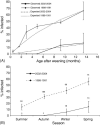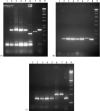Long-term reduction of Trypanosoma cruzi infection in sylvatic mammals following deforestation and sustained vector surveillance in northwestern Argentina
- PMID: 16839513
- PMCID: PMC1853287
- DOI: 10.1016/j.actatropica.2006.06.003
Long-term reduction of Trypanosoma cruzi infection in sylvatic mammals following deforestation and sustained vector surveillance in northwestern Argentina
Abstract
Long-term variations in the dynamics and intensity of sylvatic transmission of Trypanosoma cruzi were investigated around eight rural villages in the semiarid Argentine Chaco in 2002-2004 and compared to data collected locally in 1984-1991. Of 501 wild mammals from 13 identified species examined by xenodiagnosis, only 3 (7.9%) of 38 Didelphis albiventris opossums and 1 (1.1%) of 91 Conepatus chinga skunks were infected by T. cruzi. The period prevalence in opossums was four-fold lower in 2002-2004 than in 1984-1991 (32-36%). The infection prevalence of skunks also decreased five-fold from 4.1-5.6% in 1984-1991 to 1.1% in 2002-2004. Infection in opossums increased with age and from summer to spring in both study periods. The force of infection per 100 opossum-months after weaning declined more than six-fold from 8.2 in 1988-1991 to 1.2 in 2002-2004. Opossums were mainly infected by T. cruzi lineage I and secondarily by lineage IId in 1984-1991, and only by T. cruzi I in 2002-2004; skunks were infected by T. cruzi IId in 1984-1991 and by IIc in 2002-2004. The striking decline of T. cruzi infection in opossums and skunks occurred in parallel to community-wide insecticide spraying followed by selective sprays leading to very low densities of infected Triatoma infestans in domestic and peridomestic habitats since 1992; to massive deforestation around one of the villages or selective extraction of older trees, and apparent reductions in opossum abundance jointly with increases in foxes and skunks. These factors may underlie the dramatic decrease of T. cruzi infection in wild reservoir hosts.
Figures




References
-
- Anon. Recommendations from a Satellite Meeting. Mem. Inst. Oswaldo Cruz; International Symposium to commemorate the 90th Anniversary of the Discovery of Chagas Disease; Rio de Janeiro, Brazil. April 11–16, 1999; 1999. pp. 429–432. - PubMed
-
- Barnabé C, Brisse S, Tibayrenc M. Population structure and genetic typing of Trypanosoma cruzi, the agent of Chagas disease: a multilocus enzyme electrophoresis approach. Parasitology. 2000;120:513–526. - PubMed
-
- Brisse S, Barnabé C, Tibayrenc M. Identification of six Trypanosoma cruzi phylogenetic lineages by random amplified polymorphic DNA and multilocus enzyme electrophoresis. Int. J. Parasitol. 2000;30:35–44. - PubMed
-
- Carcavallo RU, Martinez A. Entomoepidemiología de la República Argentina. Investigaciones Científicas de las Fuerzas Armadas Argentinas. 1968;1:76–92.
-
- Carpenter JW, Mashima TY, Rupiper DJ. Exotic Animal Formulary. 2nd ed. W.B. Saunders Company; Philadelphia: 2001.
Publication types
MeSH terms
Grants and funding
LinkOut - more resources
Full Text Sources
Medical

